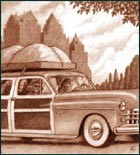By Ronald D. Utt

The mayors of some large cities share this view of the federal impact. For example, Mayor Stephen Goldsmith of Indianapolis says, "Federal urban policy drives wealth out of the cities. In fact, if we specifically designed a ‘suburban policy’ to drive investment out of our cities, it would look a lot like the current system" (Goldsmith 1997, 89). nonexistent.
A survey of 240 members of the Society for American City and Regional Planning History revealed that experts in urban history, planning, and architecture consider interstate highways and federal mortgage programs as the top two factors influencing the American metropolis over the past fifty years (Fishman 1999). Nowhere on the top ten list were such items as population growth, poor schools, or high central-city crime rates.
Yet the evidence that federal policies created sprawl is virtually nonexistent. In 1998, reflecting the popular view, Senators James M. Jeffords (R-VT) and Carl Levin (D-MI) asked the U.S. General Accounting Office (GAO) to describe the evidence that exists on the impact of current federal policies on urban sprawl. After studying the academic literature for months, the GAO (1999, 19) could not find any definitive impact and concluded that the extent of federal influence is not well documented or quantified. While this conclusion is at variance with popular perceptions, it is consistent with the factual evidence on metropolitan area growth trends. These facts are worth reviewing.
Federal mortgage insurance programs first appeared in 1934 with the creation of the Federal Housing Administration (FHA). Because of the Depression, it was not until the emergence of postwar prosperity in the late 1940s and early 1950s that homeownership took off and FHA mortgage insurance, along with the newly enacted VA mortgage guarantee for returning war veterans, became more widely used by American households.
In the fifty years prior to World War II, the homeownership rate in the United States fluctuated between 45 percent and 48 percent, except for the 1930s when it fell to 43.6 percent. It accelerated past 60 percent in the decade and a half after the war, and remained within the mid-60 percent range from 1960 through the present. However, in 1950, FHA mortgages amounted to only about a third of the volume of outstanding conventional mortgages. By 1955 FHA’s share had fallen to 29 percent and has remained well below 20 percent since 1980. In fact, by 1997, outstanding FHA mortgages amounted to just 12 percent of the volume of conventional mortgages (White House 1999, 416).
Thus, while suburbanization was surging, the FHA mortgage program was diminishing rapidly as a factor in the U.S. housing market. It is doubtful that the FHA is responsible for this surge, given its relatively modest, and declining, role in mortgage finance during the postwar era.
The period of rising homeownership and suburbanization also coincides with the rapid growth of metropolitan areas, largely the result of major demographic shifts from the countryside to more urbanized areas. In 1940, 56.5 percent of the population lived in urbanized areas, but by 1990 that share had risen to 75.2 percent as rural areas and small towns declined in population (Bureau of the Census 1975 and 1995).
Much of this shifting and growing population chose to live in the suburbs, not the central cities. In 1950, the central cities of the ten largest metropolitan areas held 60 percent of these areas’ populations, while 40 percent lived in the suburbs. But because suburban populations in 1950 were growing ten times faster than central-city populations, these shares drew even by 1960, and by 1990 had reversed themselves. The suburbs now claim a 60 percent share (GAO 1999, 1Ð5).
It is important to recognize that most of the major central cities, particularly those in the East, had been fully built to their borders by the early 1950s. Therefore, the growth in the postwar population could be accommodated only by developing the surrounding areas. At the same time, 1950 marked the peak population for many of the older central cities, and the exodus of city residents, which continues today, also contributed, albeit modestly, to the growth of population and housing in the surrounding suburbs.
Another important factor contributing to homeownership and suburbanization was the growing obsolescence of central-city housing relative to what the postwar middle class could now afford in terms of size (house and lot), privacy, and quality. For example, in 1990, the housing in Boston’s central city was, on average, 51 years old, compared with 34 years in the suburbs. In Chicago’s central city, housing was, on average, 46 years old, compared with 24 years in the suburbs (Kasarda, Appold, Sweeney, and Sieff 1997, 315). Given the age and condition of central-city housing, it is not surprising that newly prosperous postwar households were attracted to homes that were bigger and better.
The federal highway program was created in 1956 to build a limited access, highspeed interstate highway system to link America’s cities. Criticism on the grounds that it was depleting the cities emerged in the system’s earliest days, even when only a fraction of today’s network was completed. However, this theory gets little support from the facts.
Most older American cities hit their population peaks in 1950 and declined steadily through the decades that followed. The decline was underway even before the interstate highway program became law in 1956. By 1960, when all the older Eastern cities were losing population and suburban development was well underway, only 5,135 miles of the planned 41,000 miles of the interstate highway system were completed, mostly in rural areas (US DOT 1999). Indeed, it was not until the 1980s that residents in many older cities had convenient access to interstate highways.
By then, however, the process of urban decline and suburban growth was far along, and the segments to or through the cities had very little influence on the patterns of suburban development that followed. For example, Philadelphia’s suburbs grew steadily through the postwar era, even though Interstate 95 terminated five miles southwest of the city line until the 1980s. When completed, the interstate route traveled past suburban communities whose existence predated World War II. In fact, their location and the stubborn resistance of their residents were among the major obstacles to the completion of the highway to the city.
As the postwar evidence suggests, the patterns of suburban development in communities across the country bear little or no relationship to the presence of federal highways or federal housing policy. Rather, these patterns were influenced largely by a growing population and to a lesser extent by the decline in the quality of life and public services and the aging housing stock characteristic of most older communities.
References
Bureau of the Census. 1975. Population in Urban and Rural Territory, by Size and Place, Series A57- 72. Historical Statistics of the United States: 1790 to 1970. Washington, DC.
—. 1995. Urban and Rural Population, 1960 to 1990. Statistical Abstract of the United States, 1995. Washington, DC.
Fishman, Robert. 1999. The American Metropolis at Century’s End: Past and Future Influences. In Legacy of the 1949 Housing Act. Conference Proceedings. Washington, DC: Fannie Mae Foundation, September 30.
General Accounting Office (GAO). 1999. Community Development: Extent of Federal Influence on "Urban Sprawl" Is Unclear. GAO/RCED-99-87. Washington, DC, April.
Goldsmith, Stephen. 1997. The Twenty-First Century City: Resurrecting Urban America. Washington, DC: Regnery Publishing.
Kasarda, John D., Stephen J. Appold, Stuart H. Sweeney, and Elaine Sieff. 1997. Central-City and Suburban Migration Patterns: Is a Turnaround on the Horizon? Housing Policy Debate 8(2): 307Ð58.
U.S. Department of Transportation (US DOT). 1999. Development of the Dwight D. Eisenhower System of Interstate and Defense Highways. Washington, DC. White House. 1999. Economic Report of the President. Washington, DC: GPO, February.
Ronald D. Utt, a Senior Fellow with the Heritage Foundation, is coeditor with Jane S. Shaw of A Guide to Smart Growth: Shattering Myths and Providing Solutions (Washington, DC: Heritage Foundation, 2000). This article is excerpted from his chapter, "The Federal Role in Smart Growth."


